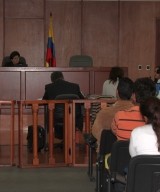Colombia continues to endure a complex conflict spanning more than four decades that has resulted in almost 400,000 registered victims and has displaced more than three million people.
Instability and “self-defense”
The beginning of modern conflict in the country is often traced back to 1948, when the public assassination of politician Jorge Eliécer Gaitán induced more than a decade of widespread violence. “La Violencia” ended with the negotiation of the “National Front” power-sharing agreement between liberal and conservative parties.
Left-wing guerilla groups began to emerge in 1962–64 in response to land reforms that displaced many people from rural areas. In the 1980s and 90s a number of these guerillas were demobilized through negotiations that offered blanket amnesties and reintegration into civilian and political life.
The two major guerilla groups that did not demobilize and continue to fight the government today are the Revolutionary Armed Forces of Colombia (Fuerzas Armadas Revolucionarias de Colombia, FARC) and the National Liberation Army (Ejército de Liberación Nacional, ELN).
|
Armed right-wing paramilitary groups emerged as locally organized “self-defense” units established by land and business owners supposedly to protect their interests against social unrest and threats from the guerilla groups. The United Self-Defense Forces of Colombia (Autodefensas Unidas de Colombia, AUC) was formally established in 1997 as an attempt to unite 18 paramilitary groups into a single command structure. Some of the most heinous crimes against civilians during the conflict have been committed by the paramilitaries. |
Contributing to the complexity is Colombia’s rise to global prominence as a hub for drug trafficking gangs, whose allegiances to parties involved in the conflict have shifted over time. Powerful interests in controlling organized crime add further fuel to conflict over land, natural resources, and political power.
Much of the violence perpetrated by the paramilitaries and guerillas has been directed at civilians, rather than meted out in confrontations between armed groups. Patterns of violence include forced displacement, disappearances, extrajudicial and summary executions, sexual violence, and the recruiting of children.
The Justice and Peace Law in crisis: Pursuing the most responsible
Consecutive administrations have attempted to disarm and demobilize the paramilitaries, with limited success. The power structures, relationships, and criminal networks extended well beyond armed factions to include high-level actors in the political and economic sectors, few of whom have been affected by either demobilization or transitional justice measures. The overarching criminal apparatus—political, military, and economic—that has supported paramilitary action for decades remains largely intact.
The Justice and Peace Law (JPL) was passed in 2005—a special “confession-driven” criminal justice mechanism permitting former paramilitary combatants to receive significantly reduced sentences in exchange for disclosing the truth about crimes committed against people and property.
The JPL represents an unprecedented opportunity to dismantle paramilitary groups, ensure non-recurrence of their terrible crimes, and restore trust in the democratic state governed by the rule of law.
| However, the law appears to be in a state of crisis. The number of “postulados”—former paramilitaries suspected of crimes that are to benefit from JPL—currently stands at more than 5,000. Analysts estimate that at least 2,000 of that number have either died or refused to take part in the process. Of the remaining 2,800, around 1,000 are currently in detention. There have been only 11 convictions in seven cases since the law was passed as many years ago. The government calculates that at the present rate, the process will take almost a century to complete. |
|
Furthermore, it is widely believed that many of current detainees are rank-and-file members of the demobilized paramilitary groups. They do not appear to have participated in the planning or ordering of crimes or to have perpetrated crimes of such egregious notoriety that would qualify them as being among the most responsible.
Selection and prioritization of cases: podcast with Paul Seils
It is fast becoming clear that the JPL needs to be reformed if it is to achieve its goal of helping convict perpetrators of serious crimes, while bringing to light truth about those who ordered, instigated, supported, or profited from them. A crucial element of the reform will have to be the criteria for selection and prioritization of cases to ensure an effective process that will see that the most responsible face justice.
In a podcast with ICTJ’s vice president Paul Seils, we explore the concepts of prioritization and selection of cases and their relevance to Colombia. Who should be regarded as most responsible in cases of serious crimes? What are the differences between selection and prioritization? Are there examples where such criteria were successfully developed? These and other questions are answered in ICTJ’s latest podcast.
Download | Duration: 19:10mins | File size: 10.9MB
Photo: Justice and Peace process hearing at the Court of Bogotá. Astrid Elena Villegas
